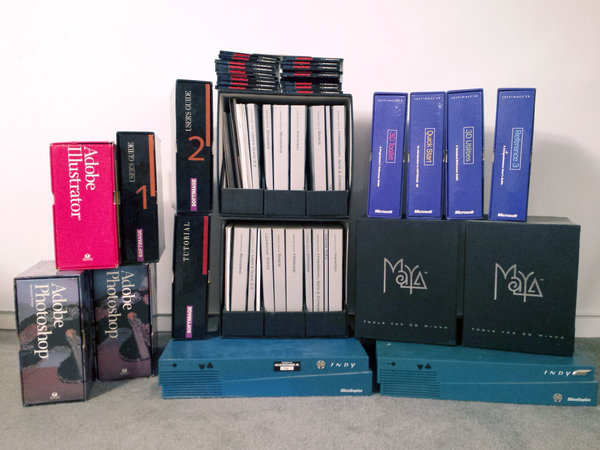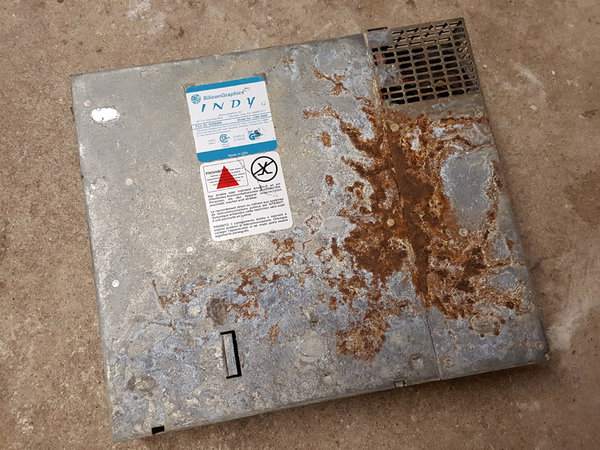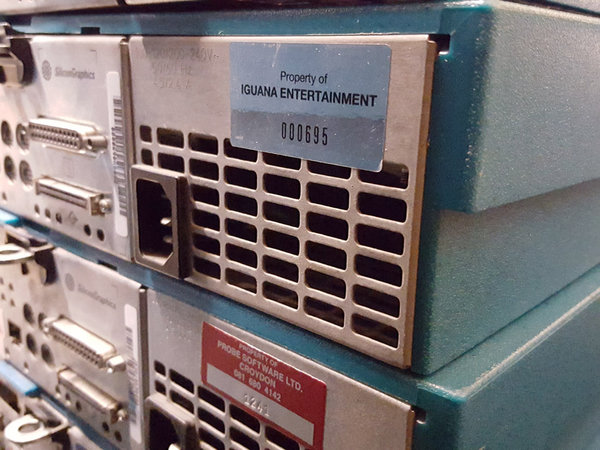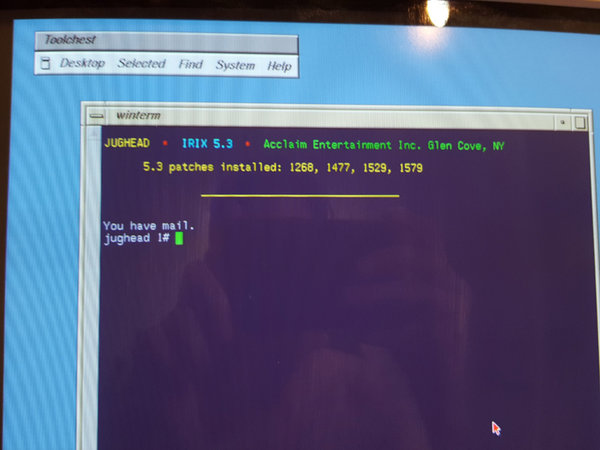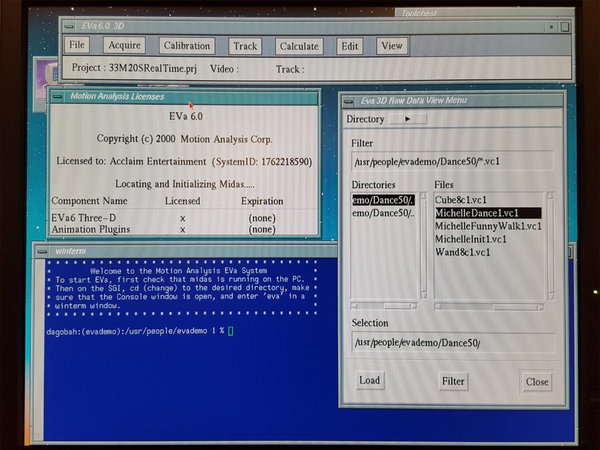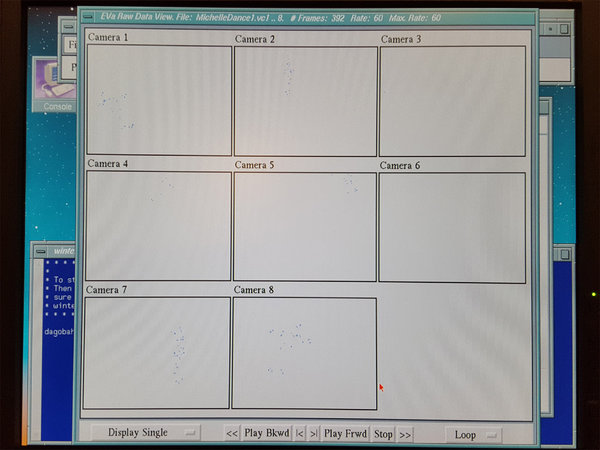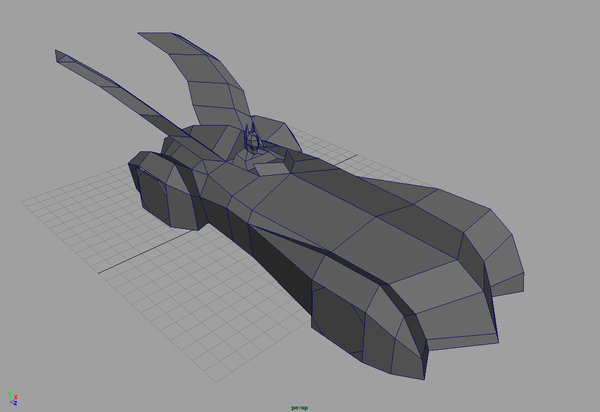Does it move as much air as the original O2 fan? Would it be safe to upgrade a 400MHz R12K system this way?
The collected works of SiliconClassics - Page 3
Best IRIX apps for:
2D: Photoshop, Amazon Paint, Illustrator, Elastic Reality, TVPaint
3D: Maya, Softimage|3D, LightWave 3D, PowerAnimator
Productivity: Wordperfect, FrameMaker
Video: Piranha, Jaleo, Shake, discreet I/F/F
Of course the exact choice of app depends on your needs - video editing vs. video compositing, image manipulation vs. page layout, etc. What exactly do you intend to do with your Fuel?
2D: Photoshop, Amazon Paint, Illustrator, Elastic Reality, TVPaint
3D: Maya, Softimage|3D, LightWave 3D, PowerAnimator
Productivity: Wordperfect, FrameMaker
Video: Piranha, Jaleo, Shake, discreet I/F/F
Of course the exact choice of app depends on your needs - video editing vs. video compositing, image manipulation vs. page layout, etc. What exactly do you intend to do with your Fuel?
Interesting - the latest video certainly adds a lot of legitimacy to their claims. Looks like they've definitely got an actual, unique, innovative product.
However, you may have noticed that the "island" environment in the video made generous use of instantiation - there was a lot of repeated geometry, in fact it looked as though there were only a few unique tiles of land that they combined to create the larger world environment. This makes sense when you consider that volumetric graphics primitives take lots and lots of memory since they're basically three-dimensional bitmap images. To store enough unique voxels to create the entire island would probably require terabytes of RAM, which is impossible on contemporary PC systems, and to run their proprietary "pixel search" graphics algorithm on a terabyte-sized database stored on disk would take forever. Hence, they store and load a reasonable amount of unique graphics data, and then repeat it ad nauseam to make the environment look large. So, the graphics detail is "unlimited" only in the sense that their system can draw environments of arbitrarily large size, as long as these environments are composed of a limited number of unique models.
For all practical purposes, this means that any developer using this engine must resort to a "tiled" approach to environment construction (not unlike Minecraft). This basically means that they will need some talented artists to build a small but versatile set of repeatable geometic primitives that can be instantiated and combined to create convincing world maps. For some games, this will not be a problem. The Sims, as mentioned in the video, comes to mind since by nature it lends itself to a tile-based graphics system. But for large outdoor FPS games like Crysis, it might make more sense to stick with polygons, or perhaps an engine that combines polygons and voxels for maximum efficiency. Ex: use polygons to create a large non-repeating ground surface, then detail it with instantiated voxel rocks and plants.
Despite this limitation of their "unlimited" technology, I'd still invest in their company. They really do deserve accolades for what they've accomplished. I'll bet a dual-600MHz Octane with enough RAM could probably do a decent job running their engine.
However, you may have noticed that the "island" environment in the video made generous use of instantiation - there was a lot of repeated geometry, in fact it looked as though there were only a few unique tiles of land that they combined to create the larger world environment. This makes sense when you consider that volumetric graphics primitives take lots and lots of memory since they're basically three-dimensional bitmap images. To store enough unique voxels to create the entire island would probably require terabytes of RAM, which is impossible on contemporary PC systems, and to run their proprietary "pixel search" graphics algorithm on a terabyte-sized database stored on disk would take forever. Hence, they store and load a reasonable amount of unique graphics data, and then repeat it ad nauseam to make the environment look large. So, the graphics detail is "unlimited" only in the sense that their system can draw environments of arbitrarily large size, as long as these environments are composed of a limited number of unique models.
For all practical purposes, this means that any developer using this engine must resort to a "tiled" approach to environment construction (not unlike Minecraft). This basically means that they will need some talented artists to build a small but versatile set of repeatable geometic primitives that can be instantiated and combined to create convincing world maps. For some games, this will not be a problem. The Sims, as mentioned in the video, comes to mind since by nature it lends itself to a tile-based graphics system. But for large outdoor FPS games like Crysis, it might make more sense to stick with polygons, or perhaps an engine that combines polygons and voxels for maximum efficiency. Ex: use polygons to create a large non-repeating ground surface, then detail it with instantiated voxel rocks and plants.
Despite this limitation of their "unlimited" technology, I'd still invest in their company. They really do deserve accolades for what they've accomplished. I'll bet a dual-600MHz Octane with enough RAM could probably do a decent job running their engine.
I actually collect old video cards like this one, and I'd happily buy it from you if I didn't already own one, a complete boxed set in fact. You might want to try eBay, as there are retro video card collectors on there who will snatch old cards like this if the price is right.
I would also guess hardware, with likely culprits being failing capacitors in the motherboard or power supply, or improper installation of a heat sink.
If you have an O2Cam, you might try the demos that use the camera input as a dynamic texture map on 3D objects. That's one of the O2's more unique and impressive abilities, stemming from its unified memory architecture.
Fascinating screenshots, thank you for posting them. The interface is elegant and many of its fundamental design elements are still a staple of modern 3D apps decades later.
I'll always love the hard-edged, instantly-recognizable CG appearance that vintage apps tended to produce. Like watercolor or bronze, 80's and early 90's CG had a look all its own, but the focus in recent decades has been photorealism. I'd love to see some talented artists produce a new movie using the tools and techniques of twenty years ago.
I'll always love the hard-edged, instantly-recognizable CG appearance that vintage apps tended to produce. Like watercolor or bronze, 80's and early 90's CG had a look all its own, but the focus in recent decades has been photorealism. I'd love to see some talented artists produce a new movie using the tools and techniques of twenty years ago.
Someone just posted
this
to eBay. It's the first I've ever heard of a Silicon Graphics branded slot machine. Judging from the "Odyssey" branding I'm guessing it's from the late 90's / early 2000's. Has anyone ever seen or used one of these? Why do they even exist?
EDIT: According to this press release , the slot machine was actually made by a company called Silicon Gaming, Incorporated in 1997. The press release repeatedly refers to the company as "SGI" but it makes no mention of Silicon Graphics as either a parent company or partner. And according to this article the slot machine was built using standard PC components, which suggests that Silicon Graphics had nothing to do with its design or construction. I'm guessing that Silicon Gaming got a strongly-worded letter from SGI's legal department later that year (or if not, I'd have to wonder what SGI legal was smoking, as this pretty clearly fits the standard of confusing similiarity to a registered mark).
More info here .
EDIT: According to this press release , the slot machine was actually made by a company called Silicon Gaming, Incorporated in 1997. The press release repeatedly refers to the company as "SGI" but it makes no mention of Silicon Graphics as either a parent company or partner. And according to this article the slot machine was built using standard PC components, which suggests that Silicon Graphics had nothing to do with its design or construction. I'm guessing that Silicon Gaming got a strongly-worded letter from SGI's legal department later that year (or if not, I'd have to wonder what SGI legal was smoking, as this pretty clearly fits the standard of confusing similiarity to a registered mark).
More info here .
TVpaint definitely doesn't have a node-based architecture with interconnecting modules - it's a very simple app.
There weren't many node-based graphics apps in the early to mid 90's - perhaps you are thinking of Softimage Eddie? There's a quick screengrab of it here .
There weren't many node-based graphics apps in the early to mid 90's - perhaps you are thinking of Softimage Eddie? There's a quick screengrab of it here .
It was a very buggy release
. Softimage released a ton of revisions in rapid succession, but apparently issues remained. I believe 2.66 was the last of the 2.x releases.
Nice to see it up and running! Yes, I made a
video about the VFX1
a couple of years ago.
Like you, I had difficulty finding a video card that was compatible with the VIP board, so I ended up using a Diamond Stealth 3D 2000, which doesn't really have any 3D acceleration features to speak of. Apparently the VESA feature connector was an ill-defined standard that was implemented differently by manufacturers. Even the Stealth 3D 2000 Pro, a slightly newer board from Diamond, doesn't work properly.
But once you finally get it all working, it's a lot of fun to toy with.
Like you, I had difficulty finding a video card that was compatible with the VIP board, so I ended up using a Diamond Stealth 3D 2000, which doesn't really have any 3D acceleration features to speak of. Apparently the VESA feature connector was an ill-defined standard that was implemented differently by manufacturers. Even the Stealth 3D 2000 Pro, a slightly newer board from Diamond, doesn't work properly.
But once you finally get it all working, it's a lot of fun to toy with.
Well done Foetz, thanks! Did it come with any sample scenes?
Yes, please
 It would be great to see some screenshots and renders of sample scenes.
It would be great to see some screenshots and renders of sample scenes.
 It would be great to see some screenshots and renders of sample scenes.
It would be great to see some screenshots and renders of sample scenes.
Creating a Saab 9000 addon car for Viper Racing, my favorite racing sim. It's almost 20 years old but there are still enthusiast web sites that provide all the tools and information necessary to make new cars and tracks. Software I've used in the process: RealViz ImageModeler 4, Photoshop 5.5, 3D Studio MAX 2.5, Maya 3.0, Zmodeler 1.07.
The Saab is about 90% finished, need to record audio of the engine and polish some of the textures.
The Saab is about 90% finished, need to record audio of the engine and polish some of the textures.
At this point most the electrolytic caps in almost all Color Classics have failed and need to be replaced, preferably with tantalums. That could be the root of your problem. Be sure to wash any leaked electrolyte off your motherboard and be careful when removing the old caps because it's easy to lift a pad if you do it wrong. There are some good guides online if you Google around for them.
Could also be bad caps in the analog / power board, but you should start with the motherboard and see what happens. CCs have a power switch on the back but it's just a cutoff - the system is powered on via the keyboard only.
Could also be bad caps in the analog / power board, but you should start with the motherboard and see what happens. CCs have a power switch on the back but it's just a cutoff - the system is powered on via the keyboard only.
I'm sorting through a bunch of Indys that used to belong to Acclaim Entertainment, the now-defunct developer of games like Turok Dinosaur Hunter and NBA Jam. It's quite a story and after years in storage the systems are finally starting to reveal their secrets.
These Indys, more than a dozen in total, came into my possession via a Russian who operated out of a warehouse in Brooklyn. I met him several years ago through Craigslist, when he was selling some old copies of Softimage and other IRIX software. He was a tough negotiator, but because he didn't specialize in retro SGI kit I was able to pick it all up for a good price.
He had purchased most of it from the Acclaim liquidation sale in 2005, and the software, hardware, and books sat collecting dust ever since. It was all stored in a big, dark room on two-story shelves running floor to ceiling. Thankfully, despite not being treated with the best of care, the Indys were in solid shape. Except one of them...
It was a treasure trove of vintage 3D - boxed sets of Softimage, Maya, Nichimen N-World, and dozens of mint CD-ROMs of PowerAnimator, Alias Wavefront, Explore, Composer, etc. It took two trips and hours climbing over industrial shelves to retrieve it all, only for it to sit silently in my storage unit until last week, when I finally started to sort through it.
Despite the fact that these systems are two decades old and use the Nidec power supplies, almost all of them boot up and run perfectly. Here's one that still has a couple of old user accounts - Mimoun Ouchaou and Nick Schipano , who according to Mobygames and LinkedIn are programmers.
Many of the systems have old source code, art assets, motion capture data, and licenses, which I will carefully preserve for posterity. It will no doubt take weeks to sift through it all. I'll post updates with interesting finds along the way.
These Indys, more than a dozen in total, came into my possession via a Russian who operated out of a warehouse in Brooklyn. I met him several years ago through Craigslist, when he was selling some old copies of Softimage and other IRIX software. He was a tough negotiator, but because he didn't specialize in retro SGI kit I was able to pick it all up for a good price.
He had purchased most of it from the Acclaim liquidation sale in 2005, and the software, hardware, and books sat collecting dust ever since. It was all stored in a big, dark room on two-story shelves running floor to ceiling. Thankfully, despite not being treated with the best of care, the Indys were in solid shape. Except one of them...
It was a treasure trove of vintage 3D - boxed sets of Softimage, Maya, Nichimen N-World, and dozens of mint CD-ROMs of PowerAnimator, Alias Wavefront, Explore, Composer, etc. It took two trips and hours climbing over industrial shelves to retrieve it all, only for it to sit silently in my storage unit until last week, when I finally started to sort through it.
Despite the fact that these systems are two decades old and use the Nidec power supplies, almost all of them boot up and run perfectly. Here's one that still has a couple of old user accounts - Mimoun Ouchaou and Nick Schipano , who according to Mobygames and LinkedIn are programmers.
Many of the systems have old source code, art assets, motion capture data, and licenses, which I will carefully preserve for posterity. It will no doubt take weeks to sift through it all. I'll post updates with interesting finds along the way.
tomvos wrote: You have a boxed set of Nichimen N-World? I wanted to see this in action for a long time.
Yep, here's part of it:
It's installed and licensed on one of the Indys, but I need to kill the passwords before I can access the user account that runs it. Been dying to see it in action too. If I can get it working I'll post some screens.
Some of these Indys have inventory stickers that didn't seem related to Acclaim, so I began to wonder if the Russian had acquired them from different companies.
The badges carry the names Sculptured Software, Iguana Entertainment, and Probe Software...
But after a little digging, it made sense. Sculptured Software was a video game developer founded in 1984 in Salt Lake City, Utah that did a lot of arcade ports in the 80s and 90s. Their credits include titles like Mortal Kombat and a number of Star Wars / WWF games. Acclaim bought them in 1995, changed their name to Iguana West in 1997, and finally rechristened them Acclaim Studios Salt Lake City in 1999.
Iguana Entertainment was founded in 1991 in Sunnyvale, CA and moved to Austin in 1993. They did a lot of console titles - a bunch of NHL/NFL games, NBA Jam,Turok, etc. They were also bought by Acclaim in 1995 and subsequently renamed Acclaim Studios Austin.
Probe Software was founded in 1984 in Croydon, England. They worked on titles for a whole range of consoles including the ZX Spectrum, Game Gear, Sega Saturn, Amiga, NES, etc. Credits include Crazy Taxi, Re-Volt, Die Hard, and a lot more. Acclaim was really on a tear in 1995 because they bought Probe that year along with the aforementioned studios, renaming it Acclaim Cheltenham.
So eventually, these Indys from Texas, Utah, and England all wound up in New York at Acclaim's liquidation sale, then sat on a shelf in a riverfront Brooklyn warehouse for a decade.
The badges carry the names Sculptured Software, Iguana Entertainment, and Probe Software...
But after a little digging, it made sense. Sculptured Software was a video game developer founded in 1984 in Salt Lake City, Utah that did a lot of arcade ports in the 80s and 90s. Their credits include titles like Mortal Kombat and a number of Star Wars / WWF games. Acclaim bought them in 1995, changed their name to Iguana West in 1997, and finally rechristened them Acclaim Studios Salt Lake City in 1999.
Iguana Entertainment was founded in 1991 in Sunnyvale, CA and moved to Austin in 1993. They did a lot of console titles - a bunch of NHL/NFL games, NBA Jam,Turok, etc. They were also bought by Acclaim in 1995 and subsequently renamed Acclaim Studios Austin.
Probe Software was founded in 1984 in Croydon, England. They worked on titles for a whole range of consoles including the ZX Spectrum, Game Gear, Sega Saturn, Amiga, NES, etc. Credits include Crazy Taxi, Re-Volt, Die Hard, and a lot more. Acclaim was really on a tear in 1995 because they bought Probe that year along with the aforementioned studios, renaming it Acclaim Cheltenham.
So eventually, these Indys from Texas, Utah, and England all wound up in New York at Acclaim's liquidation sale, then sat on a shelf in a riverfront Brooklyn warehouse for a decade.
There's an Anthony Rossano book called "Inside Softimage 3D" that was published by New Riders in 1998 - it's probably the best introduction to Soft|3D outside of the original manuals, and it's fun to skim because it's filled with full-color illustrations. You can buy it on eBay for $5.
Update: I've imaged all the hard drives and started digging through these Indys to see what's on their drives. Some pics:
In that last pic you can see raw mocap marker points as photographed by the cameras. Acclaim had a substantial mocap operation in the late 90s that was among the most advanced in the world.
The Indy I'm currently examining has the N64 dev tools installed (no board unfortunately) and a bunch of audio files from Turok and some old sports games. Will post a brief YouTube video later today.
In that last pic you can see raw mocap marker points as photographed by the cameras. Acclaim had a substantial mocap operation in the late 90s that was among the most advanced in the world.
The Indy I'm currently examining has the N64 dev tools installed (no board unfortunately) and a bunch of audio files from Turok and some old sports games. Will post a brief YouTube video later today.
Quite a wave of butthurt from angry geeks who are upset that I won't be openly engaging in copyright violation at great personal expense (looking at you, Pentium). As was my intention from the beginning, I'm going to post each of these Indys to eBay with their original contents intact, with 20% to charity. Anyone who takes issue with that can take a hike.
That would be pretty awesome!
spiroyster wrote: Dare I say it, an Irix port?
That would be pretty awesome!
Dreamworks is supposedly the actual IP rights holder for Turok, but neither they nor anyone else has any legal standing to subpoena me about this sale. And I'm happy to report that the buyer is someone whom I know from past transactions - a stand-up individual who is exactly the kind of person who can be trusted to take care of this relic.
Sorry, I didn't mean to suggest that the buyer would leak the code, just that he would properly preserve it and prevent it from being lost. And yes, the law does generally impose accomplice / conspiracy liability on someone who picks another person to do the dirty work, so I couldn't rightfully strike a deal with someone to buy the Indy and "fence" the code without exposing myself to potential legal consequences. But that's all hypothetical, and at this point nobody can know exactly what's going to happen with the contents of this Indy in the coming months.
Thanks, I was just about to post an update

The NBA Jam discovery got picked up by Gamasutra , Kotaku , and a few other news outlets. This weekend I sat down with some of the other CDR discs and found some original high-res sprites for Batman Forever . Scrounged a bunch of 3D character models and mocap data for Shadow Man, which I just sent to Valiant Entertainment, which holds the IP rights.
Also found a bunch of 3D Batman models, apparently artwork for Acclaim's later "Batman & Robin" 3D game for PSX, which apparently sucked but had decent graphics:
That Indy also contains art for several other games, and will be going up on eBay in the next week or two. The "c3po" Indy that just sold on eBay contains mocap for one of the Dave Mirra BMX titles.
Spoke with Jason Scott at the Internet Archive about options for archiving all this stuff without releasing it publicly and getting into legal trouble. I might end up sending them an encrypted copy of everything and holding the key until a rights holder grants permission for content to be released, and/or willing the key to the Internet Archive upon my demise so that it can be eventually decrypted and released upon copyright expiration. Hopefully that would avoid any legal snafus.

The NBA Jam discovery got picked up by Gamasutra , Kotaku , and a few other news outlets. This weekend I sat down with some of the other CDR discs and found some original high-res sprites for Batman Forever . Scrounged a bunch of 3D character models and mocap data for Shadow Man, which I just sent to Valiant Entertainment, which holds the IP rights.
Also found a bunch of 3D Batman models, apparently artwork for Acclaim's later "Batman & Robin" 3D game for PSX, which apparently sucked but had decent graphics:
That Indy also contains art for several other games, and will be going up on eBay in the next week or two. The "c3po" Indy that just sold on eBay contains mocap for one of the Dave Mirra BMX titles.
Spoke with Jason Scott at the Internet Archive about options for archiving all this stuff without releasing it publicly and getting into legal trouble. I might end up sending them an encrypted copy of everything and holding the key until a rights holder grants permission for content to be released, and/or willing the key to the Internet Archive upon my demise so that it can be eventually decrypted and released upon copyright expiration. Hopefully that would avoid any legal snafus.
In the spirit of Foetz's more well-researched reviews of notable SGI graphics packages, here's a brief overview of Nichimen's N-World suite, a game-centric 3D toolkit that was popular in the late '90s. Screenshots have been taken from the software and from the accompanying
HTML documentation pages
(check 'em out!). Splash screen:
From a 1998 press release by Nichimen: "Nichimen Graphics is a leading supplier of 3D graphics software for game development and interactive entertainment. Nichimen Graphics focuses its efforts on supporting the interactive content market, providing developers with the industry's most open system and leading-edge modeling and animation technology... The company's suite of packages is truly integrated, dramatically simplifying game content generation..."
N-World was widely used in the development of console games in the late '90s, notably for Super Mario 64 and Final Fantasy VII. The software itself was written using a Lisp-based development environment called Allegro CL : "Nichimen chose Allegro CL from Franz Inc. to develop its powerful N-World products... Bob Coyne, Director of Software Development at Nichimen, explains why Allegro CL's Common Lisp/CLOS was the best choice for this kind of product. 'We benefit from the usual advantages of Lisp. Programming in Allegro CL allows concepts and designs to be fluidly expressed in code, and the language and environment don't get in the way...'" N-World's origins in Lisp make sense as it was derived from S-Graphics , the 3D animation system from Symbolics workstations, acquired by Nichimen after Symbolics went under.
N-World, like many 3D packages in the '90s, was organized as a suite of programs, each tailored to a particular part of the graphics production process:

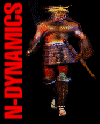
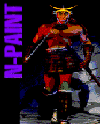

From a 1996 E3 press release : N-Geometry was a 3D polygon-based modeler, N-Dynamics offered animation scripting and choreography, N-Render performed photorealistic rendering (including raytracing), and N-Paint was a 2D/3D paint system. N-World also included game-specific tools like color reduction, a visual PSX VRAM editor , and export to Nintendo 64, Sony Playstation, and Sega Saturn. When Alias|Wavefront's Maya debuted in 1998, Nichimen's Game Engine 2.0 code was bundled with it as part of a collaboration between the two companies.
N-World would later evolve into a package called Mirai that included nonlinear animation, advanced inverse kinematics, and biomechanical motion editing tools, presumably to process motion captured animation, which was increasingly used in game development. While it never achieved the widespread industry adoption of packages like PowerAnimator, Maya, and 3dsmax, N-World and its successors were a significant tool for game developers in the late '90s / early 2000s and offered some very useful and unique features, particularly in the realm of polygonal modeling.
Screenshots:
From a 1998 press release by Nichimen: "Nichimen Graphics is a leading supplier of 3D graphics software for game development and interactive entertainment. Nichimen Graphics focuses its efforts on supporting the interactive content market, providing developers with the industry's most open system and leading-edge modeling and animation technology... The company's suite of packages is truly integrated, dramatically simplifying game content generation..."
N-World was widely used in the development of console games in the late '90s, notably for Super Mario 64 and Final Fantasy VII. The software itself was written using a Lisp-based development environment called Allegro CL : "Nichimen chose Allegro CL from Franz Inc. to develop its powerful N-World products... Bob Coyne, Director of Software Development at Nichimen, explains why Allegro CL's Common Lisp/CLOS was the best choice for this kind of product. 'We benefit from the usual advantages of Lisp. Programming in Allegro CL allows concepts and designs to be fluidly expressed in code, and the language and environment don't get in the way...'" N-World's origins in Lisp make sense as it was derived from S-Graphics , the 3D animation system from Symbolics workstations, acquired by Nichimen after Symbolics went under.
N-World, like many 3D packages in the '90s, was organized as a suite of programs, each tailored to a particular part of the graphics production process:




From a 1996 E3 press release : N-Geometry was a 3D polygon-based modeler, N-Dynamics offered animation scripting and choreography, N-Render performed photorealistic rendering (including raytracing), and N-Paint was a 2D/3D paint system. N-World also included game-specific tools like color reduction, a visual PSX VRAM editor , and export to Nintendo 64, Sony Playstation, and Sega Saturn. When Alias|Wavefront's Maya debuted in 1998, Nichimen's Game Engine 2.0 code was bundled with it as part of a collaboration between the two companies.
N-World would later evolve into a package called Mirai that included nonlinear animation, advanced inverse kinematics, and biomechanical motion editing tools, presumably to process motion captured animation, which was increasingly used in game development. While it never achieved the widespread industry adoption of packages like PowerAnimator, Maya, and 3dsmax, N-World and its successors were a significant tool for game developers in the late '90s / early 2000s and offered some very useful and unique features, particularly in the realm of polygonal modeling.
Screenshots:
Just made the contents of
Hot Mix 16 available online
. This compilation dates from 1997 and includes a
catalog
of the major software packages available on the IRIX platform along with some screenshots and promotional videos (including the one where Steve Jobs
raves about the Octane
).
Enjoy!
Enjoy!
According to the Night Dive devs
in this thread
they did have a copy of the original source.









